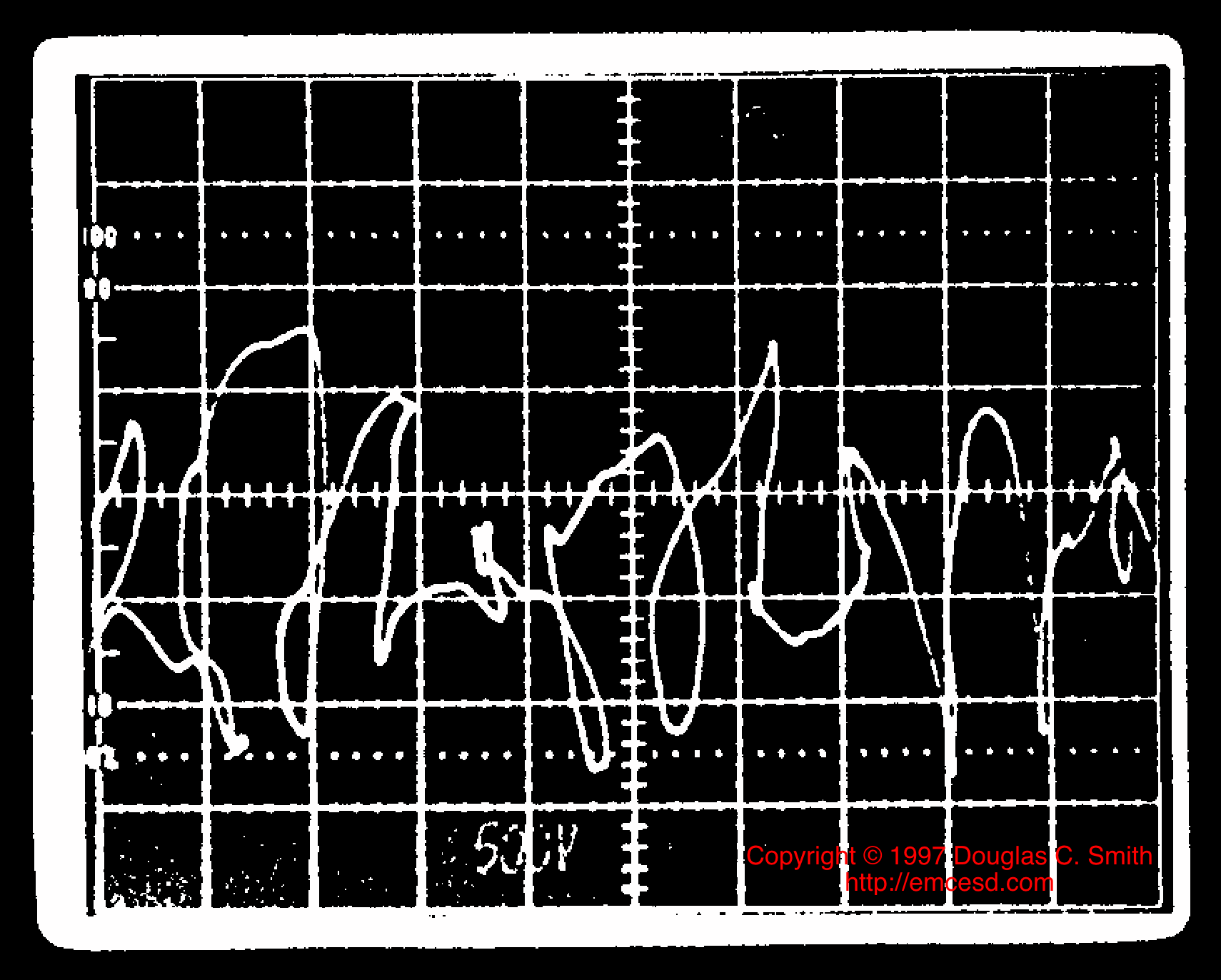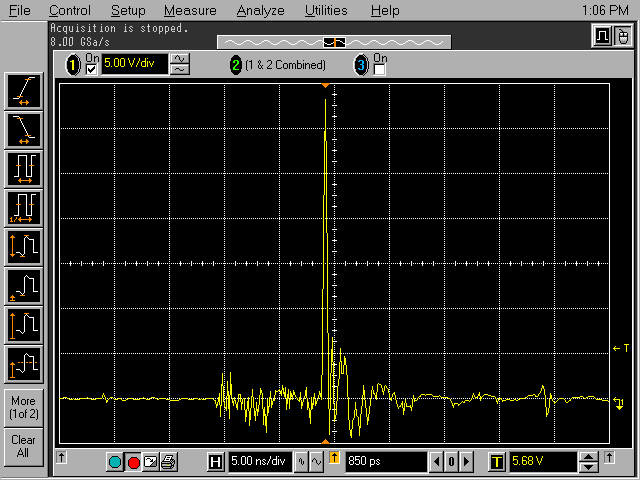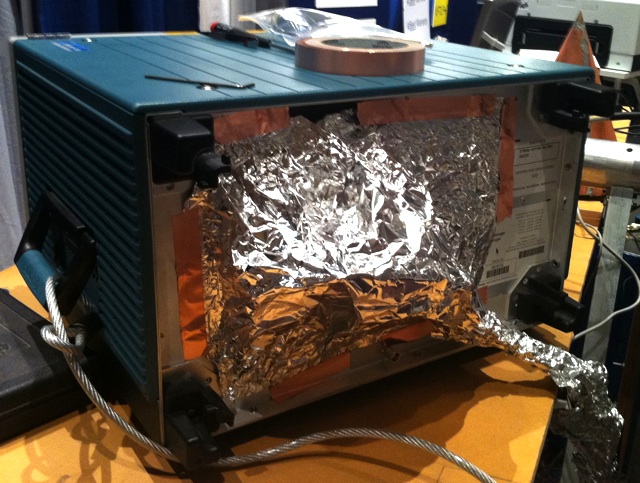
Figure 1. Example of ESD Induced Error in an Analog Oscilloscope
Abstract: When debugging
designs or making electrical measurements of noise, especially ESD, we
often assume the only equipment in the room that works perfectly is our
measurement equipment. This assumption can be wrong and when it
is, the bad data that results can add significantly to the time needed
to get to the cause of a design problem. Examples of ESD interference
to oscilloscopes are described and one innovative approach to minimizing
EMI induced error is shown.
Discussion: Figure 1 shows an
attempt to measure a waveform associated with an ESD event using a high
bandwidth analog scope many years ago. Almost every engineer or
technician trying to make such a
measurement in that time frame obtained a plot like Figure 1. The plot
was taken using a 1 GHz bandwidth Tektronix 7104 analog scope with a
camera mounted on the scope to capture the waveform. The 7104 was the
last of the analog scopes in general use just before digital scopes
became fast enough to take over most lab measurements.
In the plot of Figure 1, time appears to go backwards! What really happened was that the very strong fields generated by the ESD simulator interacted directly with the electron beam in the oscilloscope, overriding what the scope deflection systems were trying to do. The result drove the electron beam all over the screen, resulting in the strange waveform in the figure. People quickly learned to put these scopes in a Faraday Cage when making ESD measurements. The Faraday Cage shielded the scope from the ESD generated fields, and the desired waveform was obtained.
These days we use digital scopes with solid state displays that don't use electron beams the way analog scopes did, but it is still possible to get EMI induced error in scope measurements. One example can be seen in my Technical Tidbit article September 2004, Mobile Phone Response to EMI from Small Metal ESD. One of the figures from that article is reproduced in Figure 2.

Figure 2. Example of ESD Induced Error in a Digital Oscilloscope
(Vertical scale = 5 Volts/div, Horizontal scale = 5 ns/div)
EMI can manifest itself in other ways as well including crosstalk between scope channels when trying to measure a high amplitude signal and a small one on different channels at the same time. I have even seen, back in the early 1990s, a scope change its state because its control circuits were not immune to the effects of ESD. The results of this problem were quite evident though so there is little danger of bad data from this cause.
The effects of EMI on analog and digital scopes are quite different, but in both cases, significant measurement error can occur if care is not taken.
In the plot of Figure 1, time appears to go backwards! What really happened was that the very strong fields generated by the ESD simulator interacted directly with the electron beam in the oscilloscope, overriding what the scope deflection systems were trying to do. The result drove the electron beam all over the screen, resulting in the strange waveform in the figure. People quickly learned to put these scopes in a Faraday Cage when making ESD measurements. The Faraday Cage shielded the scope from the ESD generated fields, and the desired waveform was obtained.
These days we use digital scopes with solid state displays that don't use electron beams the way analog scopes did, but it is still possible to get EMI induced error in scope measurements. One example can be seen in my Technical Tidbit article September 2004, Mobile Phone Response to EMI from Small Metal ESD. One of the figures from that article is reproduced in Figure 2.

Figure 2. Example of ESD Induced Error in a Digital Oscilloscope
(Vertical scale = 5 Volts/div, Horizontal scale = 5 ns/div)
The plot in Figure 2 was the voltage
induced into a small dipole antenna tuned to about 1800 MHz in response
to jingling coins in a plastic bag. The desired signal is the tall
spike in the middle of the plot. But notice the "hash" noise starting
about 10 ns before the spike. This noise traveled over the direct path through
the air from the ESD events into the scope electronics. The hash starts
earlier because the propagation time is faster for the air path than
through several feet of coax cable the desired signal had to travel
through. To fix this and similar problems one can use a Faraday Cage
around the scope or simply move the scope further away from the source
of the EMI, jingling coins in this case.
Figure 3 shows one solution by a friend of mine, Jon Barth of Barth Electronics in Boulder City, NV, to the problem of ESD interference to his scope and PC while trying to measure the calibration waveform of an ESD simulator. ESD noise was getting into the connection between his PC and the scope, making data acquisition nearly impossible. The copper tape and aluminum foil shield did the job for him and is much simpler to implement quickly than a Faraday Cage.

Figure 3. Makeshift Shield to Prevent ESD Induced Measurement Error
Figure 3 shows one solution by a friend of mine, Jon Barth of Barth Electronics in Boulder City, NV, to the problem of ESD interference to his scope and PC while trying to measure the calibration waveform of an ESD simulator. ESD noise was getting into the connection between his PC and the scope, making data acquisition nearly impossible. The copper tape and aluminum foil shield did the job for him and is much simpler to implement quickly than a Faraday Cage.

Figure 3. Makeshift Shield to Prevent ESD Induced Measurement Error
EMI can manifest itself in other ways as well including crosstalk between scope channels when trying to measure a high amplitude signal and a small one on different channels at the same time. I have even seen, back in the early 1990s, a scope change its state because its control circuits were not immune to the effects of ESD. The results of this problem were quite evident though so there is little danger of bad data from this cause.
The effects of EMI on analog and digital scopes are quite different, but in both cases, significant measurement error can occur if care is not taken.
Summary: Don't
assume your measurement equipment is working perfectly, especially
around ESD. Be on the lookout for error creeping into your measurements.
Additional articles on this website related to this topic are:
- July 2004, Induced Voltages via Electric and Magnetic Fields - ESD Immunity
- August 2004, Wi-Fi (Wireless LAN) Antenna Response to EMI from Small Metal ESD
- September 2004, Mobile Phone Response to EMI from Small Metal ESD
- November 2004, Crosstalk Between Oscilloscope Channels and Other Errors
Click here to see information on my upcoming seminar in Newport Beach, CA.
Need help with a design or additional training on technical subjects? Click on the image below to go to CircuitAdvisor.com, a new engineering resource for training, news, and fun.
Need help with a design or additional training on technical subjects? Click on the image below to go to CircuitAdvisor.com, a new engineering resource for training, news, and fun.
If you like the information in this article and others on this website,
much more information is available in my courses. Click here
to see a listing of upcoming courses on design, measurement, and
troubleshooting of chips, circuits, and systems. Click here to see upcoming seminars in Newport Beach, CA.
Click here for a description of my latest seminar titled (now also available online as a WebEx seminar):
EMC
Lab Techniques for Designers
(How to find EMC problems and have some confidence your system will pass EMC testing while it is still in your lab).
(How to find EMC problems and have some confidence your system will pass EMC testing while it is still in your lab).
Home

